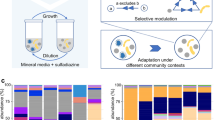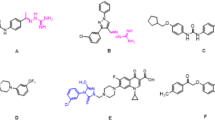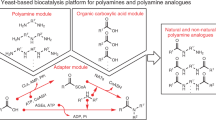Abstract
THE problem of the chemical identification of p-aminobenzoic acid has become important in view of its well-known action as antagonist of sulphonamides and the theory of Fildes and Woods concerning the mode of action of sulphonamides. Microbiological methods will always leave some doubt as to specificity, and the frequently used diazotization methods (suggested, for example, for estimation of p-aminobenzoic acid by Eckert1) are known to be unspecific and will be shown to give misleading results. So far, the presence of p-aminobenzoic acid has been established only for yeast2,3 by methods requiring large amounts of material.
This is a preview of subscription content, access via your institution
Access options
Subscribe to this journal
Receive 51 print issues and online access
$199.00 per year
only $3.90 per issue
Buy this article
- Purchase on SpringerLink
- Instant access to full article PDF
Prices may be subject to local taxes which are calculated during checkout
Similar content being viewed by others
References
Eckert, H. W., J. Biol. Chem., 148, 192 (1943).
Rubbo, S. D., and Gillespie, J. M., Nature, 146, 838 (1940).
Blanchard, K. C., J. Biol. Chem., 140, 919 (1940).
Landy, M., Larkin, N. W., Ostwald, O. E., and Streightoff F., Science, 97, 265 (1943).
Landy, M., and Gerstung, R. B., J. Bact., 48, 448 (1944).
Mirick, G. S., J. Clin. Invest., 21, 628 (1942).
Sevag, M. G., and Green, M. N., J. Bact., 47, 450 (1940); 48, 615, 623, 631 (1944).
Author information
Authors and Affiliations
Rights and permissions
About this article
Cite this article
LEMBERG, R., TANDY, D. & GOLDSWORTHY, N. Identification of Aminobenzoic Acids in Relation to Bacterial Metabolism. Nature 157, 103 (1946). https://doi.org/10.1038/157103a0
Issue date:
DOI: https://doi.org/10.1038/157103a0



